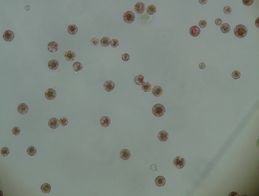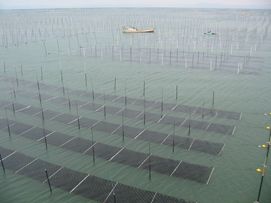
|

|
Genome Sequence of Marine Red Alga, Susabi-nori
| Overview |
We determined the genome sequence of susabi-nori (Pyropia yezoensis), preparing the symbiont-free protoplasts. Our work has been published in the journal PLOS ONE on March 11, 2013.
Press Release (In Japanese) (March 12, 2013)
| Download |
To download the sequence data of contigs and predicted genes
|
|
| Published paper |
Yoji Nakamura, Naobumi Sasaki, Masahiro Kobayashi, Nobuhiko Ojima, Motoshige Yasuike, Yuya Shigenobu, Masataka Satomi, Yoshiya Fukuma, Kouji Shiwaku, Atsumi Tsujimoto, Takanori Kobayashi, Ichiro Nakayama, Fuminari Ito, Kazuhiro Nakajima, Motohiko Sano, Tokio Wada, Satoru Kuhara, Kiyoshi Inouye, Takashi Gojobori, Kazuho Ikeo (2013): The First Symbiont-Free Genome Sequence of Marine Red Alga, Susabi-nori (Pyropia yezoensis). PLOS ONE
(doi: 10.1371/journal.pone.0057122)
(doi: 10.1371/journal.pone.0057122)
| Abstract |
Nori, a marine red alga, is one of the most profitable mariculture crops in the world. However, the biological properties of this macroalga are poorly understood at the molecular level. In this study, we determined the draft genome sequence of susabi-nori (Pyropia yezoensis) using next-generation sequencing platforms. For sequencing, thalli of P. yezoensis were washed to remove bacteria attached on the cell surface and enzymatically prepared as purified protoplasts. The assembled contig size of the P. yezoensis nuclear genome was approximately 43 megabases (Mb), which is an order of magnitude smaller than the previously estimated genome size. A total of 10,327 gene models were predicted and about 60% of the genes validated lack introns and the other genes have shorter introns compared to large-genome algae, which is consistent with the compact size of the P. yezoensis genome. A sequence homology search showed that 3,611 genes (35%) are functionally unknown and only 2,069 gene groups are in common with those of the unicellular red alga, Cyanidioschyzon merolae. As color trait determinants of red algae, light-harvesting genes involved in the phycobilisome were predicted from the P. yezoensis nuclear genome. In particular, we found a second homolog of phycobilisome-degradation gene, which is usually chloroplast-encoded, possibly providing a novel target for color fading of susabi-nori in aquaculture. These findings shed light on unexplained features of macroalgal genes and genomes, and suggest that the genome of P. yezoensis is a promising model genome of marine red algae.
 Bacteria free protoplasts of P. yezoensis. An average diameter is about 20μm. |
 thalli of P. yezoensis |
 Aquaculture of susabi-nori around a Japanese coast |
| Contact Email |
NRIFS - Laver Genome Research Group
FRA-bioinfo@ml.affrc.go.jp
FRA-bioinfo@ml.affrc.go.jp
Copyrights © NRIFS-FRA All rights reserved.